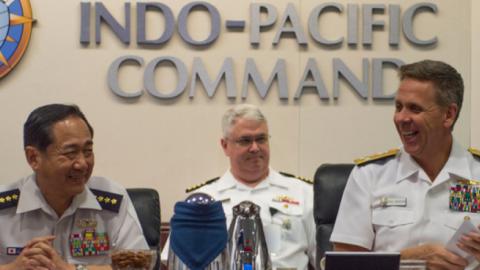It is not surprising that American regional security experts and strategists strongly support U.S. withdrawal from the Intermediate-Range Nuclear Forces (INF) Treaty. Particularly in Japan, my colleagues and I had already considered how China is influencing the current security environment in the Indo-Pacific region. Which is why we need to discuss what the best option is for regional allied force structure, especially since Japan is a potential host nation for U.S. ground-based missiles.
As Eric Sayers, former special assistant to the U.S. Indo-Pacific Command (INDOPACOM) Commander, and Elbridge Colby, former deputy assistant secretary of defense for strategy and force development and a key figure for the 2018 National Defense Strategy (NDS), argue, the United States needs to strengthen its strategic and operational flexibility to redefine its power projection capabilities in the Indo-Pacific.
There are several approaches to filling capability gaps and improving U.S. power projection cost-effectiveness: upgrading air and missile defense posture; strengthening bases in Guam and Okinawa; establishing additional airstrips in Southeast Asia; increasing the number of strategic bombers and cruise missile submarines (SSGNs); and deploying land-based missiles.
One of the advantages of land-based missiles is cost-effectiveness. The deployment of land-based missiles is cheaper than sea-launched (SLCMs) and air-launched (ALCMs). Furthermore, road-mobile missile launchers would incentivize China to invest in more missile-defense and ISR capabilities. However, in determining the appropriate regional force posture, it is necessary to consider not only military efficiency but also political reality and sustainability. It is essential to discuss what the target is, the need launchers and missiles, the necessary lethality, and the appropriate deployment of these systems.
Let’s begin with weapon selection and lethality in the case of mobile targets. First, there is no need to deploy intermediate-range ground-launched missiles for counter-targeting. Nuclear-tipped missiles for retaliation can also be launched from ballistic missile submarines (SSBNs) and bombers. Moreover, if conventional missiles are used, there is insufficient lethality for counter-targeting. Secondly, subsonic ground-launched cruise missiles (GLCMs) are not suitable against time-sensitive targets like transporter erector launchers (TELs), except in the case of large-scale attacks. While ballistic missiles are faster than cruise missiles, their accuracy is not sufficient enough to hit small targets.
In the case of fixed targets, both ballistic and cruise missiles are sufficient to destroy their intended targets. However, more than 600 tactical ballistic missiles would be required to properly disable the more than 40 distributed airstrip networks in China. Furthermore, an attack of this proportion would require properly placed launchers with hardened shelter or bunker facilities. As a result, these high-value facilities would become China’s priority targets for massive strikes. Using land-based intermediate “nuclear” forces would require fewer missiles, but nuclear weapons are more politically charged.
The strategic environment is critical for the successful deployment of U.S. defenses. The Chinese People’s Liberation Army (PLA) Rocket Force is asymmetric compared to the U.S-Japan alliance and can take advantage of the strategic depth to ensure the survivability of many TELs. Japan and the United States have only five to six major operational air bases in the western Pacific. A strategically reasonable option is to deploy robust and adequate land-based missiles in the Southwestern island chain, including Okinawa. However, political tension over U.S. military bases in Japan jeopardizes U.S.-Japan cooperation, and China could easily divide public opinion through information warfare. These measures must be carried out after diligent diplomacy with allies.
Given these political factors, regardless of the ground-based system, the most efficient and reliable approach is to expand the role of the Japanese Self-Defense Forces’ (JSDF) offensive and defensive capabilities, seamlessly combining them with U.S. conventional and nuclear capabilities.
What should we do?
The framework of deterrence in Asia today is (1) flexible strike capability consisting of nuclear and non-nuclear forces, (2) comprehensive and robust missile defenses, (3) joint commitment through military exercises, and (4) consultation mechanism on extended deterrence. The Japanese government strongly supports the 2018 Nuclear Posture Review (NPR) with two low-yield nuclear options.
To begin, we should upgrade the Extended Deterrence Dialogue (EDD), the consultative framework for strengthening and deepening mutual understanding of the deterrence of the U.S-Japan alliance, to a form that integrates high-level consultations like the U.S.-Japan Security Consultative Committee. Therefore, integrating the EDD with the combined operational planning process through the U.S-Japan Bilateral Planning Committee and seamlessly constructing its escalation ladder from the gray-zone to the conventional and nuclear domains would be in both nations’ interest.
The amelioration of the U.S.-Japan relationship through EDD would benefit U.S.-Japan joint exercises involving not only U.S. Forces Korea and Indo-PACOM, but STRATCOM as well. Among the exercises are the plausible scenarios are crucial for success in the event of a war in the Indo-Pacific region. For example; the risk of forward deployment of dual-capable aircraft (DCA) in a time of crisis; the military and political utility of increasing the presence of DCAs and strategic bombers; and the frequency of deployment of SSGN/SSBNs in the western Pacific region; and the utility of low-yield SLBM against time-sensitive targets such as mobile missiles, based on the necessity to use them as a prompt disarming strike means.
On top of EDD, it is essential that Japan continues to utilize the Aegis Ashore, SM-3 Block II A, and SM-6 to strengthen the multilayered U.S.-Japan joint missile defense layer to cope with a combination of ballistic and cruise missile salvo attacks. To further fortify the mid-course to upper and lower-tier terminal phases of air defense system, Japan should work with the U.S. to deploy THAAD along with sensor networks. Sensors, once deployed in South Korea and Japan, will contribute not only to the defense of Japan, but to the defense of Guam, Hawaii, and the U.S. homeland as well. Finally, we should also advance technical cooperation in space-based sensor layers, such as the hosted payload of space-based kill assessment satellites and pre-boost phase defense technology so-called “left of launch."
In addition, the implementation of joint R&D programs for offensive and defensive hypersonic technologies is necessary. China and Russia have already developed various hypersonic systems, such as boost gliders and air-breathing missiles. Japan Acquisition, Technology, & Logistics Agency (ATLA) has been researching HVGP (Hyper Velocity Gliding Projectile) since FY2018 to provide better remote island defense.
Finally, by distributing strike capabilities, the U.S will reduce the vulnerability of its forward-deployed assets. A combination of the F-35 and F-15 or submarine and Tomahawk missiles should be considered. The latest version of the Tomahawk can be launched from a torpedo tube and fits Japanese submarines without the vertical launch system (VLS). As a result, as the SDF takes charge of attacks on fixed targets, U.S. forces will be able to effectively concentrate on time-sensitive targets.
Overall, the most effective combination includes medium-range ballistic and cruise missiles and HVGP with the Ground Self Defense Force in order to utilize long-range anti-ship missiles. Once the United States is not restricted by the INF Treaty, it is also possible to operate the U.S.-Japan joint-developed tactical HVGP and long-range anti-ship missiles such as the land-based LRASM in coordination with U.S Army or Marine Corps troops to block the chokepoints of the first island chain. These missiles could be staged in Kyushu during peacetime, and during contingencies, it could rapidly deploy to the Southwestern islands by U.S.-Japanese joint ground forces. The deployment of heavy payload ballistic missiles capable of high-angled attacks to disable runways and other fixed hard targets might also be an option to complement U.S. naval and air force operations.
Japan should not only seek reassurance from the United States but should reassure its ally through its own efforts in the manner proposed to continue to encourage the United States to continue its commitment to security in the Indo-Pacific.



















